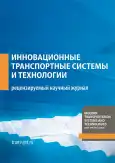Оценка потока отказов транспортных средств по изменению параметра израсходованного ресурса
- Авторы: Замота Т.Н.1, Лошаков А.С.1, Турушина Е.В.1
-
Учреждения:
- Луганский государственный университет имени В. Даля
- Выпуск: Том 10, № 4 (2024)
- Страницы: 618-629
- Раздел: Оригинальные статьи
- URL: https://bakhtiniada.ru/transj/article/view/277929
- DOI: https://doi.org/10.17816/transsyst632001
- ID: 277929
Цитировать
Полный текст
Аннотация
Цель. Статья рассматривает методы технической диагностики узлов и систем транспортных средств по значению параметра израсходованного ресурса.
Методы. Разработка системы контроля за потоком отказов, которая позволит своевременно их выявлять, прогнозировать развитие поломок и применять меры технического воздействия.
Результаты. Параметрами для оценки надежности являются состояние подвески и рулевого управления и компрессия при оценке двигателя.
Заключение. Разработка интеллектуальных систем диагностирования и прогнозирования позволит повысить эффективность и надежность автомобилей в условиях реальной эксплуатации.
Полный текст
Открыть статью на сайте журналаОб авторах
Тарас Николаевич Замота
Луганский государственный университет имени В. Даля
Автор, ответственный за переписку.
Email: zamota71@rambler.ru
ORCID iD: 0000-0002-9904-4518
SPIN-код: 4443-7346
доктор техн. наук, профессор, зав. кафедрой «Автомобильный транспорт»
Россия, ЛуганскАлександр Сергеевич Лошаков
Луганский государственный университет имени В. Даля
Email: keksvruke@yandex.ru
ORCID iD: 0009-0004-5690-7186
SPIN-код: 5820-4660
аспирант, ассистент кафедры «Автомобильный транспорт»
Россия, ЛуганскЕлена Викторовна Турушина
Луганский государственный университет имени В. Даля
Email: dahl.univer@yandex.ru
ORCID iD: 0009-0000-8108-0089
старший преподаватель кафедры «Автомобильный транспорт»
Россия, ЛуганскСписок литературы
- Zamota TN, Zamota ON, Grinko ET. Improvement of the passenger car operation system with the existing accuracy of parts and flow analysis. Scientific Bulletin of the Lugansk State Agrarian University. 2021;3(12):283–290. (In Russ.)
- Zamota TN, Aulin VV, Panayotov KK, et al. Technical and economic aspects of improving the strategy of maintenance and repair of vehicles. Lugansk: Noulidzh, 2022. (In Russ.)
- Zamota TN, Smetana SA, Zamota ON, et al. Technical and economic approaches to improving the system of maintenance and repair of buses. Scientific bulletin of the Lugansk State Agrarian University. 2022;4(17):314–321. (In Russ.)
- Zamota TN, Zamota ON, Grinko ET. Analysis of the technical and economic costs of operating a car within the life cycle. Bulletin of the LSU named after V. Dahl. 2022;7(61):59–65. (In Russ.)
- Bokor Z. Cost Drivers in Transportand Logistics. Periodica Polytechnicaser. Transportation Engineering. 2010;38(1):13–17. doi: 10.3311/pp.tr.2010-1.03
- Askarany D, Yazdifar H, Askary S. Supply chain management, activity-based cost in gand organisational factors. International Journal of Production Economics. 2010;2:238–248. doi: 10.1016/j.ijpe.2009.08.004
- Kabanov IS. Development of an information automated system for the study of controlled models of reliability and efficiency. [dissertation] Moscow; 2004. (In Russ.)
- Zorin AI. Improving the efficiency of maintenance of agricultural mechanization facilities on the basis of organizational and engineering measures on the example of the Udmurt Republic. [dissertation] St. Petersburg; 2006. (In Russ.)
- Kurlyshev OV. Methods and software and hardware for remote monitoring of the condition of vehicle components. [dissertation] Izhevsk; 2006. (In Russ.)
- On approval of fuel and lubricants consumption standards in road transport dated June 08, 2020, Lugansk No. 139 [internet] Accessed: 23.05.2024. Available from: https://mintrans-lnr.su/
Дополнительные файлы









